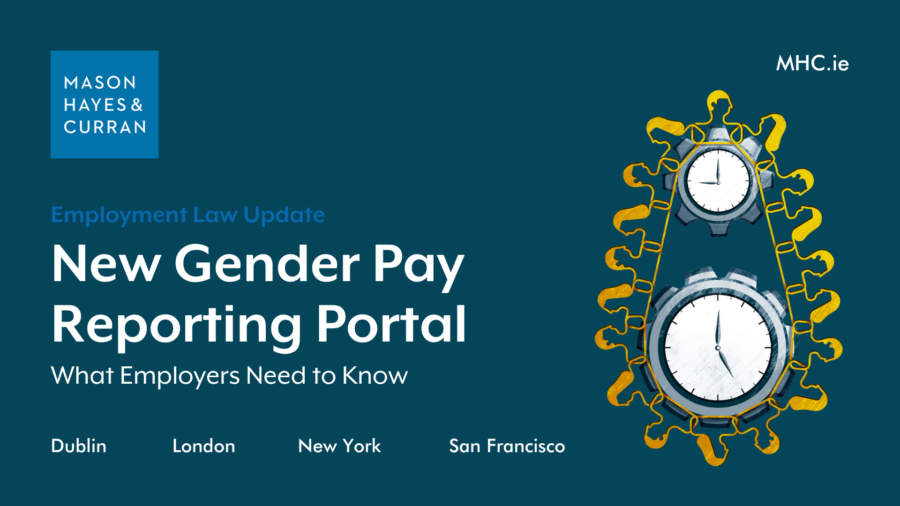
The Minister for Children, Equality, Disability, Integration and Youth of Ireland has announced the introduction of a new gender pay reporting portal. The online portal will simplify the process of gender pay gap reporting by consolidating reports from all in-scope public and private sector organisations onto one database. Our Employment & Benefits team discusses the benefits of this portal and employer reporting obligations.
What you need to know
- Mandatory reporting expansion: From June 2025, gender pay gap reporting applies to employers with 50 or more employees.
- Centralised portal: A searchable platform for public access to pay gap data is due to be launched in autumn 2025.
- Transparency focus: The portal aims to encourage businesses to address pay disparities.
- Benefits of the portal: It will ensure enhanced transparency, searchability of reports, improved comparability, reduced administrative burden for employers and will help strengthen employer brand.
- Preparation is key: Employers should review pay structure, conduct internal audits, engage with employees and review their internal policies in advance of this year’s reporting deadline.
Introduction
The Minister for Children, Equality, Disability, Integration and Youth of Ireland has announced the introduction of a new gender pay reporting portal. The new online portal simplifies the process of gender pay gap reporting by consolidating reports from all private and public sector organisations onto one accessible database. The portal is intended to replace the requirement for organisations to publish reports on their own websites. However, the option will remain for employers to upload reports, with more information, to their own websites should they wish.
Updated regulations will be required to facilitate this change ahead of this year’s reporting deadline of the end of November.
Gender pay gap reporting
The gender pay gap is the difference between the average hourly wages of men and women in an organisation. The Gender Pay Gap Information Act was enacted in 2021. The Act requires organisations to report on their hourly gender pay gap across a range of metrics. Initially, the obligation applied to employers of 250+ employees. The threshold was lowered in 2024 to 150 employees and from 2025, reporting is mandatory for all organisations in Ireland with 50 employees or more. Employers are required to choose a ‘snapshot’ date in June every year upon which to base their reporting. At present, in-scope organisations must publish their report on their website or in another way that is accessible to all its employees and to the public. It must be available for a period of at least three years commencing from the date of publication. Previously, the reporting deadline was December of the relevant year. In 2025, the reporting deadline is November.
Benefits of the portal
The introduction of the gender pay gap reporting portal offers advantages for both employers and employees:
Enhanced transparency: By centralising gender pay data onto one searchable platform, the portal will increase public awareness of wage disparities, encouraging businesses to adopt fairer practices.
Searchability: The portal is intended to be fully searchable by members of the public. It is intended that this feature will increase the utility of gender pay gap reporting.
Improved comparability: The portal will make it easier for stakeholders to compare pay gap data across industries, sectors and organisations.
Reduced administrative burden: The centralised platform will likely simplify the reporting process by replacing individual company-based publication methods, saving businesses time.
Strengthened employer brand: Through improved comparability, the portal may indirectly improve employee morale, aid employers in attracting top talent and to position themselves as inclusive employers.
5 key steps for employers
- Audit payroll data: Ensure your pay data is accurate and complete.
- Identify disparities: Conduct an internal review to pinpoint potential pay gaps and assess their causes.
- Prepare a narrative statement: Organisations must provide commentary as to any pay gaps in their report and outline the steps being taken to address them.
- Engage with employees: Transparent communication about pay gap reporting with employees can build trust and reinforce commitment to equality.
- Review policies: Examine recruitment, promotion, and bonus structures to ensure they promote equal opportunities.
Conclusion
With the introduction of the gender pay gap reporting portal, Ireland is aligning with international best practices in workplace transparency. For employers, this obligation is not just about compliance - it is an opportunity to build stronger, fairer workplaces.
To learn more about gender pay gap reporting, please read our previous insights:
- Gender Pay Gap Regulations Published
- Update on Gender Pay Gap Reporting- Ireland
- The Pay Transparency Directive
Contact our Employment Law and Benefits team to find out more.
People also ask
| Who needs to report on pay gaps in Ireland? |
| From June 2025, employers with 50 or more employees will be required to publish their gender pay gap report. |
| Currently, where do employers share their pay gap report? |
| Employers must publish their pay gap report either on their website or in another way that is accessible to all of its employees and to the public. It must be available for a period of at least three years beginning with the date of publication. The Irish government has indicated that it intends to develop a centralised reporting portal which will be live from autumn 2025. |
The content of this article is provided for information purposes only and does not constitute legal or other advice.
Share this:

